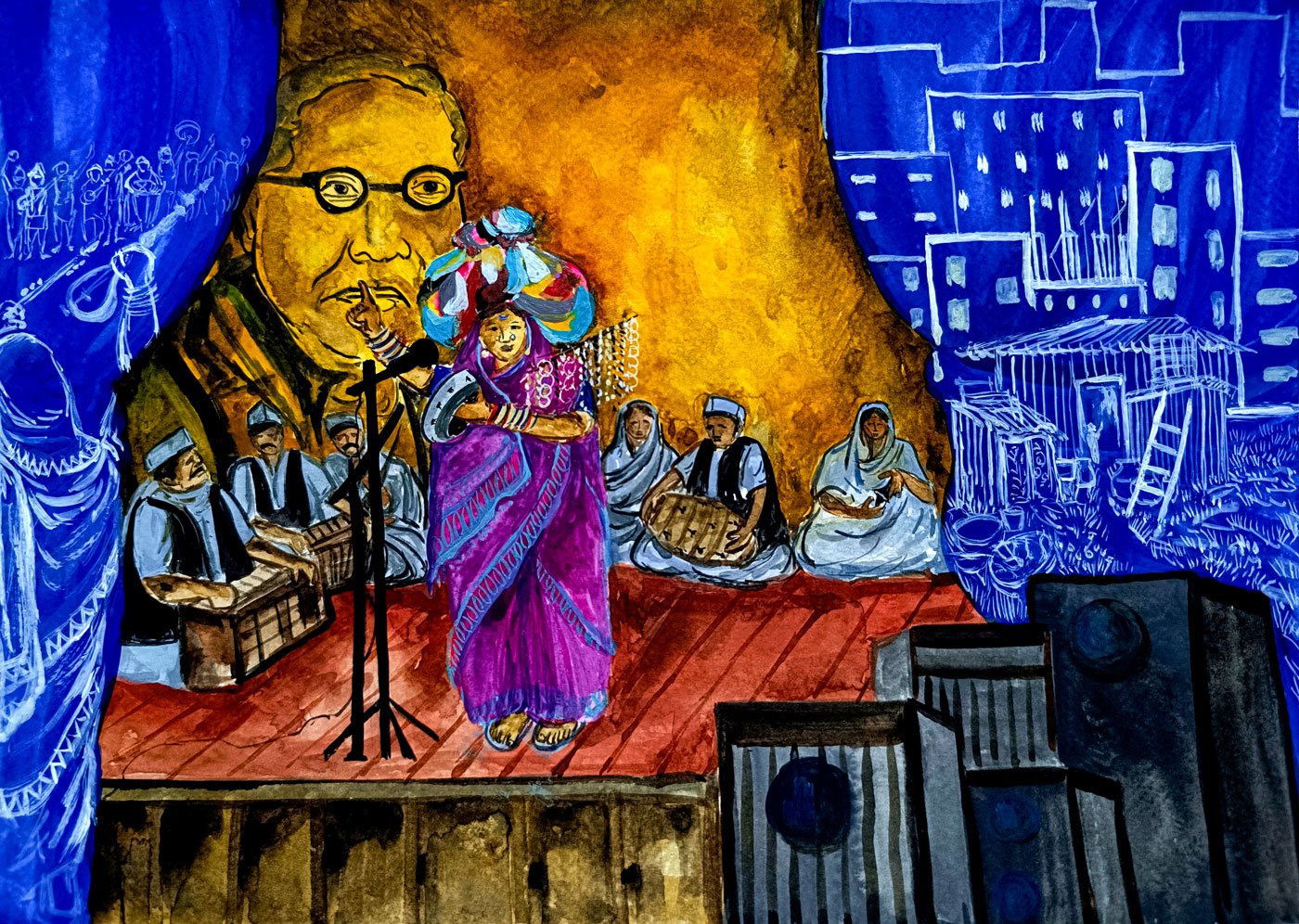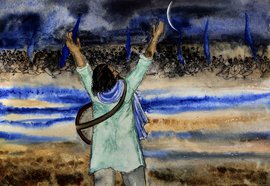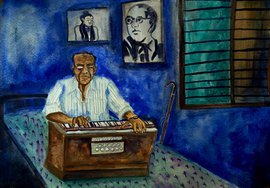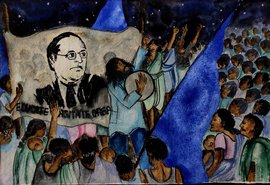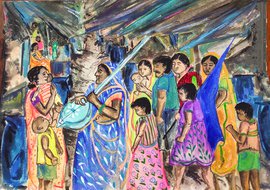A man is travelling on foot towards Pandharpur with his seven-year-old daughter on an annual pilgrimage, the Ashadhi Waari – a festival where thousands of warkaris from across the state pay a visit to the temple of Lord Vitthal. On the way they decide to camp at Mhaisgaon, a village in Latur. As evening gathers, sounds of kirtan fill the air. The little girl, on hearing a faint tintinnabulation of the khanjiri (tambourine), begins pestering her father to take her to the programme.
Her father is reluctant. “People here do not touch Mahar and Mang like us,” he tries to explain. “They consider us worthless. They won’t let us in.” But she refuses to budge. Finally, the father gives in to her demand on condition that they stand at a distance and listen to the performance. Following the sound of the jingles they both reach the pandal . Rapt, they both watch maharaj playing the khanjiri as he performs a kirtan. Soon, the young girl begins to get restless, she wants to go on the stage. Suddenly, without a warning, she runs and does just that.
“I want to sing one bharud [a form of ancient poetry that deploys satire and humour in songs composed for social enlightenment],” she tells the saint performer on the stage. The audience is stunned. But the maharaj lets her sing. And for the next few minutes the young girl takes the stage, striking a metal pot for rhythm, she performs a song that happens to be the one written and composed by the same maharaj.
माझा
रहाट
गं
साजनी
गावू
चौघी
जनी
माझ्या
रहाटाचा
कणा
मला
चौघी
जनी
सुना
The wooden wheel on the well, my dear
Four of us, let’s sing together
The
wooden wheel and its spine,
And four daughters-in-law of mine
Impressed by the child
singer, the saint performer gifts his
khanjiri
to her saying, “you have
my blessings, always. You will enlighten this world.”
Watch the video of Meera Umap singing a traditional Bharud, known for its use of satire and metaphors, open to multiple interpretations
That was 1975. The saint performer was Tukadoji Maharaj, known for his verses compiled in Gram Geeta, on the ills and perils of life in the countryside, and the way forward. The little girl, now 50 years later, still sets the stage on fire with her performances. Dressed in a nauvari cotton saree, a large bindi on the forehead, with a small percussion instrument called dimadi held in her left hand, when Meera Umap sings a Bhim geet , the fingers of her right hand dance rhythmically and energetically on the the leather membrane; the glass bangles on her wrist keep the time with the jingling bells tied to the rim of the instrument she is playing. Everything comes alive.
खातो
तुपात
पोळी
भीमा
तुझ्यामुळे
डोईवरची
गेली
मोळी
भीमा
तुझ्यामुळे
काल
माझी
माय
बाजारी
जाऊन
जरीची
घेती
चोळी
भीमा
तुझ्यामुळे
साखर
दुधात
टाकून
काजू
दुधात
खातो
भिकेची
गेली
झोळी
भीमा
तुझ्यामुळे
I eat my
roti dipped in ghee, just because of you, O Bhim
The bundle
of wood I no longer carry, only because of you, O Bhim
My mother
went to a market yesterday
And bought a
zari-blouse, all because of you, O Bhim
I have my
milk with sugar and eat cashews with it
And I got rid of the
begging bowl, just because of you, O Bhim
*****
Meerabai does not know the day on which she was born, but tells us the year was 1965. She was born in a poor Matang family of Antarwali village in Maharashtra. Matangs, listed among the Scheduled Caste in the state, are historically considered ‘untouchables’ and rank lowest in the caste hierarchy.
Her father Wamanrao and
mother Reshmabai travelled from village to village in Beed district, singing
melodious
bhajan
and
abhangs
, asking for alms. They were
respected in the community as a family belonging to ‘guru gharana’, a highly
respected group of knowers and teachers in the Dalit community who preserve the
art of singing. So even though Meerabai
never went to school, she grew up with a rich repertoire of
abhang, bhajan
and
kirtan
that she received from her parents.

Shahir Meera Umap is the only woman in Maharashtra playing dimdi and khanjiri. She shows amazing skill in playing instruments that have been traditionally played by men alone
The couple had a tough time feeding and taking care of their eight children – five girls and three boys. By the time Meerabai, the eldest among the children, was seven she had started accompanying her parents when they went singing. Wamanrao played the ektari and his younger brother, Bhaurao played the dimadi. “My father and my uncle, both used to ask for alms together,” she says narrating to us the story of her singing. “Once, they had a fight over sharing the proceeds of that morning. It reached a point where they decided to part ways.”
After that day, her uncle went off to Buldana and her father got her to accompany him. She sang behind him, in her tender voice and went on to learn many devotional songs. “My father always believed that I would be a singer one day,” she says.
Later, tending to cattle for wages, she started trying her hand at the dimadi. “When I was young, metal pots were my instruments. While fetching water, my fingers tapped the kalshi , a metal pot. It became a habit, rather a hobby. All that I have learnt in life is like this, while doing other things and not in any school,” says Meerabai.
In the neighbourhood there would be little gatherings for regular bhajan singing and soon Meerabai joined those groups and started performing many bhajans .
राम
नाही
सीतेच्या
तोलाचा
राम
बाई
हलक्या
दिलाचा
Ram does not measure up to Sita
Ram, his heart is so shallow
“I never went to school but know 40 different Ramayanas by heart,” she says. “The story of Shravan baal , stories of the Pandavas from the Mahabharata, and hundreds of dohas by Kabir, are all etched in my brain.” She believes that the Ramayana is not a linear tale set in stone, but is created by people based on their culture, their worldviews and their observations. Historical challenges and disadvantages faced by many communities have brought in changes within these epics. The characters remain the same but the stories are multi-coloured and multi-faceted.
Meerabai presents it
from her position and place in the society. It differs from the way higher
caste Hindus present it. Her Ramayana has a woman, a Dalit at the centre. Why did Ram leave Sita alone
in the exile? Why did he kill Shambuka? Why did he murder Waali? She poses many
questions before her audience as she presents her stories and a logical
understanding the popular tales from the epic. “I even use humour to present
these stories,” she says.


Left: Meera Umap with the khanjiri gifted to her by saint poet Tukdoji Maharaj after watching her performance when she was barely seven. Right: Illustration of a dimadi , also a small percussion instrument made of a wooden ring and a leather membrane that Meerabai plays. Unlike dimadi , a khinjari has extra metal plates or ghungroos fitted on the outer ring. It is used by folk artists when they narrate the stories of deities and is considered an essential part of their worship
With a deep sense of music and fine understanding of technique and presentation Meerabai’s music is in a class of her own. Following the footsteps and style of Tukadoji Maharaj, an influential saint poet and reformer with a large following in Vidarbha and Marathwada, Meerabai has also scaled many heights.
Tukadoji Maharaj played khanjiri in his kirtan performances. His disciple Satyapal Chincholikar plays sapta-khanjiri in which seven khanjiri s produce different notes and sounds. Devanand Mali from Sangli and Mhalari Gajabhare from Satara also played the same instrument. But Meerabai Umap is the only woman playing the khanjiri and that too with such skill.
Shahir Ratnakar Kulkarni of Latur, who wrote the songs and played the daf (a frame drum instrument often used by shahirs ) saw her playing the khanjiri with great skill and also noticed her melodious voice. He decided to support and motivate her to perform shahiri (songs of social enlightenment) . When she was 20, she entered the field of shahiri and performed in government programmes in Beed.
“I knew all the religious texts by heart. Katha , saptah , Ramayana, Mahabharata, the story of Satyavan and Savitri, all the songs and stories of Mahadev and puranas were on the tip of my tongue,” she says. “I have narrated them, sung them and performed them in all the corners of the state. But it never ever gave me a sense of fulfilment or satisfaction. Neither did it show any new path to the people listening to those songs.”
It was Buddha, Phule, Shahu, Ambedkar, Tukadoji Maharaj and Gadge baba, those who talked of social trauma and malaise of the Bahujan communities that touched Meerabai’s heart. “Vijaykumar Gawai taught me the first Bhim geet and that was the first song of Wamandada Kardak that I performed,” Meerabai recalls.
पाणी वाढ गं माय, पाणी वाढ गं
लयी नाही मागत भर माझं इवलंसं गाडगं
पाणी वाढ गं माय, पाणी वाढ गं
Serve me water, my dear, serve me water
I
am not asking for much, just enough to fill my small gadaga [clay pot]
Serve
me water, my dear, serve me water
“From that day I stopped
singing all the
pothi puran
[bookish knowledge] and started singing the
Bhim
geet
. From 1991, the year of Babasaheb Amedbkar’s birth centenary, she
devoted herself to
Bhim geet
, songs that spread the message of Babasaheb
while expressing gratitude to him. “People simply loved it and responded to it
with all the gusto,” says
shahir
Meerabai.
Shahir comes from a Farsi word ‘ shaya r’ or ‘ shair ’. In the countryside of Maharashtra shahirs have written and sung songs glorifying the rulers called powada. Shahirs like Atmaram Salve with his khanjiri, Dadu Salve with his harmonium and Kadubai Kharat with her ektari (a drone lute) have raised Dalit consciousness through their songs. Meerabai with her dimadi joins the few women shahirs in Maharashtra. Dimadi till then was considered a war instrument, played exclusively by men. Meerabai, with her dimadi broke one more tradition.
It is an experience to listen to her sing and play the instrument, deftly using her fingers on different areas of the membrane to produce different notes, creating variations needed for different kinds of singing - kirtan , bhajan and powada . Her singing slowly picks up the pace; the sound, the performance always deeply rooted in the soil, resonates with a carefree or a bold spirit. It is her dedication that keeps the art of dimadi and khanjiri still alive and thriving.
Meerabai has been one of the few women shahir s performing bharud , a folk form used by many saint poets of Maharashtra. There are two kinds of bharud – bhajani bharud which revolves around religion and spirituality, and songi bharud in which men dress as women and perform on the stage. It is usually men who perform powada s on historical and social themes as well as bharud . But Meerabai challenged this division and started performing all the art forms with similar vigour and force. In fact, her renditions have been more popular than some of the other male performers’.
Performances with
dimadi,
songs, theatre, and a message for the audience have been much more than
entertainment for Meerabai.
*****
Art in this country is very closely linked to and judged on the basis of the caste of its creator. One learns the ways of one’s caste including the music and other arts. Will a non-Dalit, non-Bahujan be able to create and follow the notations for these instruments and learn to play these? And, even if an outsider wants to try his or her hand at dimadi or sambal or a zumbaruk , there is no codified grammar.
Students of the
Department of Music at the University of Mumbai are learning how to play the
khanjiri
and
dimadi
. Well-known artists Krushna Musale and Vijay Chavan have
created the notations for these percussion instruments. But it comes with its
own challenges, claims Ganesh Chandanshive, the Director of Lok-kala Academy at
the University.


Left: Ganesh Chandanshive, director Lok Kala Academy at the University of Mumbai. He acknowledges that neither dimadi nor sambal has its own musicology. 'No one has written down the notations or created a "science" giving it a status of a classical instrument,' he says. Right: Meerabai has aquired the knowledge of the instrument without knowing any science, notation or the grammar of its music
“You cannot teach dimadi , sambal or khanjiri in a way other classical instruments are taught,” he says. “One can only teach or learn tabla in that manner as we can put down notations for that instrument. People have tried using similar notations to teach dimadi or even the sambal . But neither of these instruments has its own musicology. No one has written down the notations or created a ‘science’ giving it a status of a classical instrument,” he explains.
Meerabai’s mastery over dimadi and khanjiri has come to her without knowing any science, the notation or the grammar of its music. She never knew if it is a dha or ta when she learnt to play. But her pace and the perfection in rhythm and notes can match that of any artist playing a classical instrument. The instrument belongs to her. No one at the Lok-Kala Academy can match Meerabai’s skill in playing the dimadi .
As Bahujan castes are coming into the middle class, there is a loss of their own traditional art and expressions. Migrating to cities for education and work, they no longer perform their traditional occupations and associated art forms. There is a desperate need to document these art forms; to understand their historical and geographical contexts of origin and practice. To address the many questions that confront us. For instance, are aspects of caste conflict, other struggles, reflected in their expressions? If yes, what are the forms in which these are expressed? The universities or educational institutions show no such vision when looking at these forms academically.
Each caste has a specific folk art and so the sheer variety is overwhelming. There is a real need for a dedicated research centre to study and archive the treasures and traditions. This, however, is not on the agenda of any non-Brahmanical movement. But Meerabai wants to change this picture. “I want to start an institute where youngsters can learn khanjiri , ektari and dholaki ,” she says.
She has not found any
support for this at the state level. Has she made an appeal to the government? “Do I know how to read and write?” she
retorts. “Whenever and wherever I go for a programme and if there is some
official from the state, I appeal to them, requesting to help me fulfil this
dream. But do you think the state values this art of poor people?”


Daf,
a percussion intrument used by shahirs performing the
powada
(songs of glory) and
tuntune,
a single string instrument used by Gondhalis
(community) to seek the blessings of
'bhavani aai'
(Tuljabhavani). Right:
Dakkalwar
community created the
kingri
, a string instrument with a resonator box of unglazed
pottery, through which a stick is passed to function as the neck. Another kind of kingri has three resonators and a wooden peacock to tune and play


Left: Sambal is used in gondhal, a ritual performed in worship of female deities. These are two wooden drums united from a side, with a leather membrane. This instrument is played with two wooden sticks, one having a curved tip. It is played by gondhalis. Right: Halgi is a circular wooden frame drum played by men from the Mang community during festivals, wedding processions and other rituals at temples and dargahs
*****
The state did invite Meerabai, though. When Meerabai’s shahiri and singing started captivating large audiences effectively, the government of Maharashtra asked her to contribute to many awareness programmes and drives carried out by the State. Soon, travelling the length and breadth of the state, she was performing little skits with elements of folk music on issues of health, de-addiction, dowry-ban and liquor-ban.
बाई दारुड्या भेटलाय नवरा
माझं नशीब फुटलंय गं
चोळी अंगात नाही माझ्या
लुगडं फाटलंय गं
My
husband is an addict
my
fate lies derelict
I
got no blouse to wear
This
saree has got a tear.
Her awareness programmes
on de-addiction earned her a Vyasanmukti Seva award from the Maharashtra government.
She was also invited to perform by All India Radio and Doordarshan.
*****
But in spite of all the good work, life has been tough for Meerabai. “I was rendered homeless and had no one to support me,” she narrates the story of her latest ill fortune. “During lockdown [2020] my house caught fire due to a short circuit. We were so desperate that there was no other option but to sell that house. We were on the streets. Many Ambedkarite followers helped me build this house,” she says, referring to her new house with tin walls and roof in which we are sitting.


Shahir Meera Umap, a folk artist and performer with many accolades and awards lives a life of struggle. Here are the images of her small tin house in Chikalthana, Chhatrapati Sambhaji Nagar
This is the situation of an artist who has been honoured with many prestigious awards in the name of many stalwarts such as Annabhau Sathe, Bal Gandharva and Lakshmibai Kolhapurkar. The government of Maharashtra also honoured her with a state award for her cultural contribution. These awards once decorated the walls of her house.
“They only please your eyes, I tell you,” Meerabai says with eyes brimming with tears, “One cannot fill one’s stomach just by looking at these. During Corona, we were starving. In those desperate moments, I had to use these awards for firewood to cook a meal. Hunger is far more powerful than these awards.”
Recognition or not, Meerabai pursues her art with unwavering devotion, walking the same path as that of the legendary reformers to spread the message of humanity, love and compassion. She is using her art and her performances to douse the communal and divisive fire. “I do not want to market my art,” she says. “ Sambhalali tar tee kala ahe, nahi tar bala ahe [If one respects it, it is art. Else, it is a scourge].
I have not let my art lose its character. For the last 40 years I have travelled to different corners of this country and spread the message of Kabir, Tukaram, Tukadoji Maharaj and Phule-Ambedkar. I have been singing their songs and their legacy lives on through my performances.
“I will sing the Bhim geet till my last breath. That will be the end of my life and that is what gives me immense satisfaction.”
This multimedia story is part of a collection titled ‘Influential Shahirs, Narratives from Marathwada’, a project implemented by India Foundation for the Arts under their Archives and Museums Programme in collaboration with People’s Archive of Rural India. This has been made possible with part support from Goethe-Institut/Max Muller Bhavan New Delhi.
